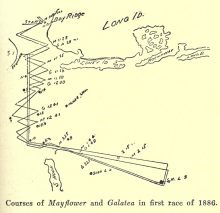 But although the elements were still, there was an unusual stir among the shipping. Big and little steamboats and tugs and steam yachts, all gaily decked with bunting and shaded with bright colored awnings, and all crowded with men and women and children, were steaming about and for the most part after 9 o’clock heading for the pleasure fleet at Bay Bridge. Some of them had brass and string bands on board that played patriotic tunes alternately with strain s from popular comic operas. When they arrived at Bay Ridge one or two struck up “Rule Britannia.” Everybody talked about the weather and spoke hopefully of the prospect of a breeze. The cause of all the stir was the first of the series of international races between the British cutter Galatea and the Yankee sloop Mayflower, selected as the representative yachts of the two nations, the prize being the America’s cup, the emblem of the world’s yachting championship. But although the elements were still, there was an unusual stir among the shipping. Big and little steamboats and tugs and steam yachts, all gaily decked with bunting and shaded with bright colored awnings, and all crowded with men and women and children, were steaming about and for the most part after 9 o’clock heading for the pleasure fleet at Bay Bridge. Some of them had brass and string bands on board that played patriotic tunes alternately with strain s from popular comic operas. When they arrived at Bay Ridge one or two struck up “Rule Britannia.” Everybody talked about the weather and spoke hopefully of the prospect of a breeze. The cause of all the stir was the first of the series of international races between the British cutter Galatea and the Yankee sloop Mayflower, selected as the representative yachts of the two nations, the prize being the America’s cup, the emblem of the world’s yachting championship.
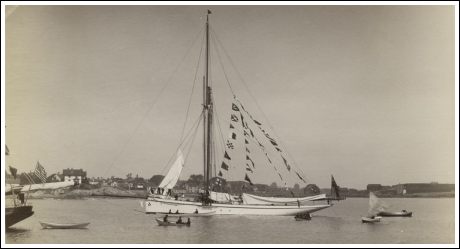
ALL READY ABOARD THE RACERS
At Bay Bridge the spectators found the champions at anchor. The Galatea had her main sail and her queer, lateen-like club topsail set, and her jib and staysail aloft in stops. Lieut. Henn appeared in a straw hat and white yachting suit. Mrs Henn stood in the companion way, just showing her head and shoulders. She wore a red Tam O’ Shanter hat and a tight-fitting blue waist. Sam Gibson was aboard to set as Yankee pilot. Lloyd Phœnix, owner of the schooner Intrepid, boarded the cutter as the representative of the New York Yacht Club and Mr. Fred May was invited on to represent himself.
“Do you want one of your men to sail on the Mayflower?” asked Chairman Chase from the Judges’ boat, the Luckenbach.
- No replied Lieut. Henn.
- Do you want a man on this boat?
- No.”
Swarthy Capt. Bradford, in his shirt sleeves, and Designer Webb in a blue yachting suit, walked about among the Galatea’s crew, giving an order now and then, and finally directing them to get up the anchor.
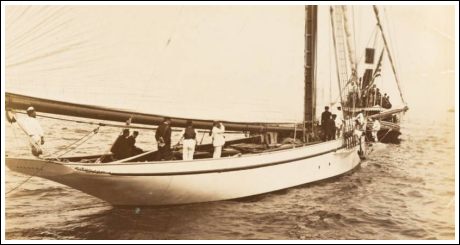
The tug Jos. Stickney passed a line to the cutter and towed her clear of the shoal of tugs, launches and sailboats that were nosing around her like fish around floating bait, and then she set jib and foresail and jogged off toward the Jersey shore. The monkey was nowhere in sight.
Gen. Paine, conspicuous in broad, red suspenders over a gray woolen shirt, walked about the deck of the Mayflower and suggested to the judges’ boat that it would be well to wait for a breeze. Mr. Tams boarded the Mayflower to sail the race in her. Designer Burgess, with a white slouch hat pulled down over his eyes, sat on the port rail with one leg hanging over the side; Capt. Joe Elsworth, as pilot, loafed about decks in his shirt sleeves; and Capt. Stone with Capt. Newcombe of the Fortuna and a lot of the Fortuna’s crew to help, looked after the jib topsail which the men were getting forward to run up in stops.
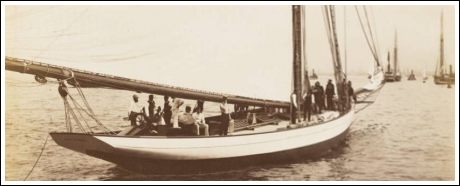
At last the Mayflower slipped her anchor, with a buoy and a spar to mark the place, and slowly reached after the Galatea. It was all that an ordinary pilot would have wanted to do to steer the boat through the gathering fleet of excursion boats, but Capt. Stone threaded his way out into clear water.
ABOUT EVERYTHING AFLOAT WAS THERE
The excursion boats were a sight to see, even at this time. They seemed to grow up out of the water like marine mushrooms, although it is somewhat of a slander on the mushroom model to compare it with some of the fleet.
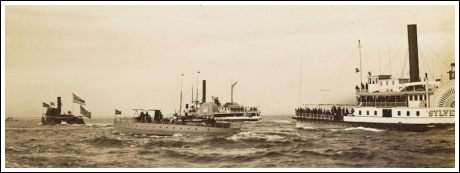 There was nearly every sort of boat known in these waters, from round-bowed bumboats, loaded with watermelons, to a tenement-house shaped cargo propeller from the Hackensack River; from the king bird launch Henrietta, darting in and out among the more lubberly vessels, to the big iron ocean steamer of the Old Dominion line; from a catboat to the beautiful schooner Ambassadress. It was utterly impossible to keep track of any but the most notable of the boats. They floated about each other like driftwood in an eddy until the tugboat Luckenbach took her position outside of the starting point, Buoy 18, off Owl’s Head, south of Bay Ridge, and then the majority of them got around on the line which the yachts were to cross. They fiddled about for half an hour or so, and the Brooklyn police boat Judge Moore was sent around to drive them away. Then they went outside and gathered about the two racers which were then, at about 10:40 o’clock filling and backing above the line and waiting for the preparatory signal. There was nearly every sort of boat known in these waters, from round-bowed bumboats, loaded with watermelons, to a tenement-house shaped cargo propeller from the Hackensack River; from the king bird launch Henrietta, darting in and out among the more lubberly vessels, to the big iron ocean steamer of the Old Dominion line; from a catboat to the beautiful schooner Ambassadress. It was utterly impossible to keep track of any but the most notable of the boats. They floated about each other like driftwood in an eddy until the tugboat Luckenbach took her position outside of the starting point, Buoy 18, off Owl’s Head, south of Bay Ridge, and then the majority of them got around on the line which the yachts were to cross. They fiddled about for half an hour or so, and the Brooklyn police boat Judge Moore was sent around to drive them away. Then they went outside and gathered about the two racers which were then, at about 10:40 o’clock filling and backing above the line and waiting for the preparatory signal.
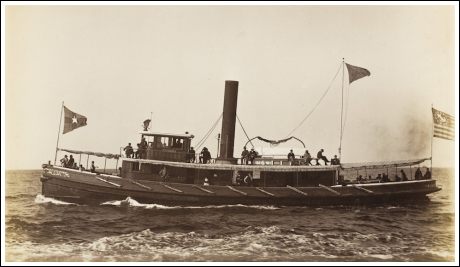
The fog had been slowly clearing all this time, rolling off up North River under a bank of cumulus clouds. Staten Island came out through a dreamy blue haze, showing the old pride of New York, the Priscilla, setting under way. The sunlight sifted down, capping the rumpled water with sliver, for at this time a soft air had begun to set from the south. There was a low bank of fog away down on the South shore of the lower bay, and a fleet of sailing yachts that had gone on before without being missed from the great throng could be seen with sails rounded and decks slightly aslant as they beat down toward the first turning point inside Sandy Hook, There was an occasional boom of cannon among the yachts after this for the skippers had become more cheerful under the prospect of a wind and began to salute each other.
THE GALATEA SMARTEST AT GETTING AWAY
 Finally the way having been cleared a little for the big racers, the long preparatory blast on the committee boat’s whistle was given at 10:46 o’clock. Both boats were then heading up toward Gowanus, the Mayflower with boom well aft and to starboard and jibs to port, and the Galatea with boom aft and jibs to port. They hung in the wind for five or six minutes, and then both slowly pointed on the starboard tack for the line. Their sails been put to sleep by the slowly freshening breeze. A minute before the signal to cross the line both yachts headed for it in a way that meant business. The Mayflower was ahead but a little on the lee bow of the Galatea and she luffed up to get to windward as she pointed for the bow of the Luckenbach. Then the signal blow gain and the jib-topsail fluttered into place. But while the Mayflower was pinching up the Galatea was getting a good full, and she came down on the weather quarter of the unfortunate Yankee like a frigate bird on a booby. They were on the starboard tack, and the Mayflower had to sag off. With the Galatea taking the wind all out of the Mayflower’s sails the two yachts crossed the line one second apart, the Mayflower inshore and away they stood toward a little green patch of a field on Owl’s Head. It was a beautiful start, and one that made the spectators give the skilful Briton hearty rounds of applause. The Galatea crossed at 10:56:11 and the Mayflower at 10:56:12. In the forty-mile race then begun the Mayflower must pick up thirty eight seconds and a fraction to win. Finally the way having been cleared a little for the big racers, the long preparatory blast on the committee boat’s whistle was given at 10:46 o’clock. Both boats were then heading up toward Gowanus, the Mayflower with boom well aft and to starboard and jibs to port, and the Galatea with boom aft and jibs to port. They hung in the wind for five or six minutes, and then both slowly pointed on the starboard tack for the line. Their sails been put to sleep by the slowly freshening breeze. A minute before the signal to cross the line both yachts headed for it in a way that meant business. The Mayflower was ahead but a little on the lee bow of the Galatea and she luffed up to get to windward as she pointed for the bow of the Luckenbach. Then the signal blow gain and the jib-topsail fluttered into place. But while the Mayflower was pinching up the Galatea was getting a good full, and she came down on the weather quarter of the unfortunate Yankee like a frigate bird on a booby. They were on the starboard tack, and the Mayflower had to sag off. With the Galatea taking the wind all out of the Mayflower’s sails the two yachts crossed the line one second apart, the Mayflower inshore and away they stood toward a little green patch of a field on Owl’s Head. It was a beautiful start, and one that made the spectators give the skilful Briton hearty rounds of applause. The Galatea crossed at 10:56:11 and the Mayflower at 10:56:12. In the forty-mile race then begun the Mayflower must pick up thirty eight seconds and a fraction to win.
![Mayflower [and] Galatea, the start. - John S. Johnston 01028S.jpg](/images/stories/1886/01028S.jpg)
SHE PICKS IT UP RIGHT AWAY.
The wind what there was of it, was coming straight through the Narrows. The Mayflower had to keep off, whether she would or not, and having her sails rap full she outfooted the Galatea, which was kept close to the wind. The Galatea was greatly bothered when across the line by the big steamer Frances that got right before her, and then gave her a lot of back wash ingetting out of the way. Both boats held on for four minutes and a half and then both went around to the port tack together with the Mayflower well on the Galatea’s quarter, both heading pretty well for the Episcopal church spire near the Staten Island Quarantine station.
Over on the Staten Island shore the usual fleet of merchant vessels could be seen at anchor with their sterns down toward the Narrows, and both yachts were anxious to get over there to get the benefit of the tail of the ebb tide. Before the racers were half way across to Staten Island, it was clear that the Mayflower had regained all she bad lost at the starting line. She was rather better handled, it appeared to the yachtsmen. Two men were seen out on the Galatea’s bowsprit while the rest of the crew were doing something about decks. On the Mayflower the men were snugged away under the weather rail. These matters are trifling, but a racing yacht is sensitive as a racehorse and even a man walking along the deck sets her to trembling, retarding her if only to a very small extent.
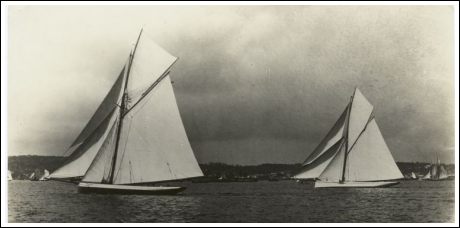
From the weather quarter of the Galatea the Mayflower passed to her weather bow. She had changed places with the cutter. The constantly growing fleet of excursion boats swarined along in the lee of the racers, that is to the right of them. Close over to the Island the Mayflower weathered a big bark at anchor while the Galatea run under its lee, or to the right of it, losing somewhat by being becalmed by the big hulk and rigging. At 11:12:30, the Mayflower came around on the starboard tack, heading to the south of Fort Lafayette out in the Narrows. The Galatea came about a minute later and with the tide to help them they were likely soon to get though the Narrows. Besides that, the wind, to the delight of everybody, freshened a trifle.
POPULOUS SHORES LOOK ON.
Going through the Narrows it was plain to the yachtsmen that a good many landsmen were interested in the race. The porticos of the new hotel at Fort Hamilton were bright with bunting and ladies and black with men. The piers from the shore seemed to afford standing room only to the crowds upon them, except to the front rows, who sat on the string pieces with their feet hanging over. The fort itself had picturesque groups of soldiers standing about near the wicked-looking, but practically harmless guns with which it is armed. The roadway and the houses swarmed with spectators.
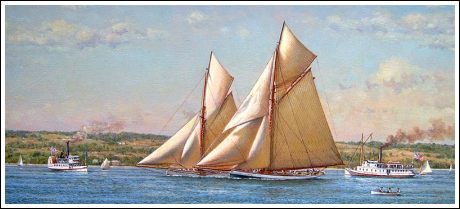
Over on Fort Wadsworth was another and a larger crowd. They swarmed over sunburned grassy slopes, sat under the shade of the trees beyond, and even covered the seawall at the water’s edge. The estimates of the number of people on both shores ran from 5.000 to 10.000. The smaller estimate was certainly too small. The lower bay was white with the slow-paced sailing yachts and no end of oyster and fishing sloops and schooners. Above these boat and over the Highlands, the fog having gone, was a long low bank of cumulus clouds, which the weather-wise said betokened a steady southeasterly wind. The giant contestants ploughed through the rippleless water toward Gravesend Bay, their small jib topsails just lifting.
A BRIDGE OF BOATS ACROSS THE NARROWS
Behind them came the steam fleet. The vessels were huddled together like a flock of ducks. The green-gray water was shut out of sight except in patches here and there that were churned into froth by wheels and propellers. It looked as though an agile man might have crossed the Narrows to Fort Lafayette from Staten Island by stepping and leaping from boat to boat. Behind them all was a countless number of rowboats and catboats that had witnessed so much of the start as could be seen over the surrounding fleet of larger craft and that hoped to be in at the finish by waiting near the stake boat.
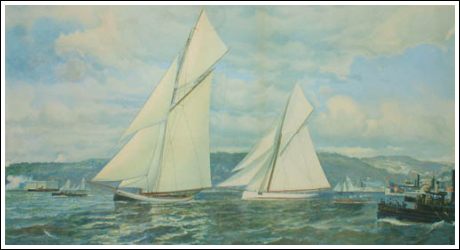
At 11h. 21m. the Mayflower went on the port tack just below Fort Lafayette and headed for New Dorp on Staten Island. She crossed the Galatea’s bows about two minutes later about six lengths ahead of her. Six minutes later still the Galatea tacked in the Mayflower’s wake. The Galatea was pinched up too close into the wind, the yachtsmen said. They also said that while the Galatea got around from one tack to the other in half the time required by the Mayflower, the sloop by forereaching or continuing to go ahead while she turned gained on her every time they went about.
THE YANKEE A WHOLE TACK AHEAD - WHOOP!
When the Galatea tacked this time in the Mayflowers wake, the Mayflower had already got so near to Staten Island that she had to come about on the starboard tack. She was now a whole tack ahead of her British competitor. This steady gain had been working on the feelings of the spectators to a remarkable extend.
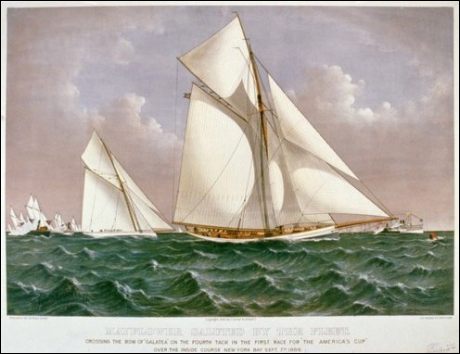
Men could be seen all over the fleet turning to their companions and talking excitedly and gesticulating wildly as they called the attention of ladies to the gain of the sloop, and when the Mayflower reached across the Galatea’s bow on this tack, the excitement proved too much for the skipper of a huge steam lighter, and reaching for his whistle cord he awoke the echoes thus:
“Toot ! Toot ! Toot-toot - t-o-o-t!”
The effect was magical and thrilling. With one accord the skippers of eighty-three other steam vessels seized their whistle cords anti answered the steam lighter with a roar of screaming, swelling, ear-spitting blasts, mingled with the bang and boom of yacht artillery, that woke the echoes of Staten Island as they had never been wakened before. There was no doubt about the patriotism of that fleet.
“Well, there is four dollars’ worth of stoam thrown away unless the Mayflower win.” said Chairman Chase of the regatta Committee.
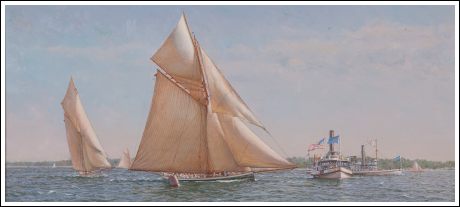
 |
|
THE ST. JOHN’S DOUSES THE GALATEA
Then the big Long Branch steamer St Johns had to come down and wholly spoil the pleasure of the tens of thousands of spectators. Rushing through the fleet of following steamers, her pilot, apparently with malice aforethought, for he could easily have avoided It, sent the big steamer across the bows of the Galatea. The big waves from the steamer’s wheel crashed against the bows of the cutter, throwing the spray high upon her jibs while the back water threw the cutter’s bow off to leeward in a way that might well have made her crew curse.
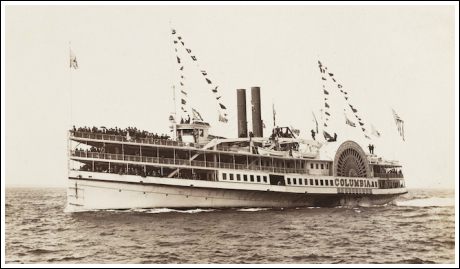
The wind held south by west and the turn of the tide was not before the first hospital Island was reached. It was plainly going to be a succession of short tacks all the way to the first turn inside the Hook. The Galatea for a time tacked oftener than the Mayflower and kept her nose close up to the wind. At noon, off the old quarantine hulk, the Mayflower had apparently increased her lead to half a mile. Near there the big National liner Italy coming in with her upper deck covered with people met the fleet. Someone on the big ship proposed three cheers for the Mayflower which were given heartily by the emigrants and answered by the spectators on the excursion boats.
Then the wind shifted a point or so to the eastward. The Galatea got the first of it, and for a mile or more made the only gains on the Mayflower that are to be put to her credit during the race. She made one long board to port while the Mayflower tacked thrice. It seemed to be anybody’s race for a while, and no cheering was done on the fleet then. But the Mayflower soon got the wind and began once more to haul away from the cutter.
THE YANKEE PICKS UP FIVE MINUTES THIS SIDE OF THE HOOK.
All Perth Amboy, Red Bank, and the rest of Jersey seemed to have boarded all the fish and oyster schooners of the bay and either anchored near the turning buoy or gone cruising in the neighborhood. Attempts to count them were fruitless, but they served to fill in such chinks as were left between the 183 steamers that had followed the racers down from the Narrows. A fair statement of the territory under water covered by the fleet would be called exaggeration. They carefully made way for the racers. The Mayflower headed for the buoy No 10 on the port tack. She fetched several lengths to leeward or to the right of it, and then at 12:55:30 came about and around the mark, heading for buoy 8½ in a line toward the fort on Sandy Hook. She had to pass to the south of the buoy. She was close hauled on the starboard tack, she receive the usual salute accorded to the leading boat in a race but it was swollen by numbers, and varied by new varieties of trembling brass vibrated by hissing steam.
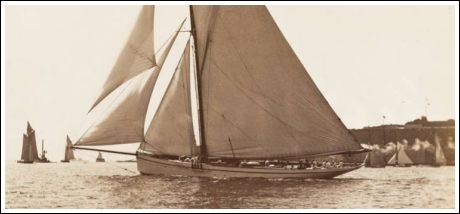
The saluting had not ceased when at 1 o’clock, or 4½ minutes afterward the Galatea followed. The gain which the Mayflower had made was therefore 4m. 31s. for the Mayflower was 1 second late at the start. At 1h. 1m. 51s the Mayflower weathered buoy 8½, the Southwest Spit Buoy, and with started sheets reached out for the black buoy of the end of Sandy Hook. She fairly seemed to fly through the water while the Galatea was pinching up into the wind to weather Buoy 8½. She did it at 1h. 7m. 7s. so that up to that point the Mayflower had gained 5m. 17s. She was still gaining rapidly, and when at last she had passed the Hook and got beyond the False Hook outside and the ugly current to the north sweeping up inside of it, she had gained at least a minute on her rival, and was also to fetch the Sandy Hook Lightship off to eastward on one board, although outside the wind was southeast by south.
PANDEMONIUM AT SANDY HOOK LIGHTSHIP.
The sailing vessels of the excursion fleet did not venture out of the Hook. It was hopeless to attempt to see the turn, but the 15,000 or 20,000 spectators on the steam fleet of 283 vessels found the weather and the sea in a perfect condition according to their tastes though not much to the liking of the cutter-loving yachtsmen. There was scarce a roller coming in. The sea looked like a green flour, with long oily breadths at interval. A long dark, hazy roll of cloud that looked like smoke coming out of the blue Highlands, hung over the water clear around to the east, betokening, the yachtsmen said, a steady breeze to the end. The fleet stretched for two mile behind the racers, looking very much like a covey of merchantmen convoyed by two trim sloops of war.

It was certainly pleasant for the excursionists. As all neared the lightship the steamers raced ahead and gathered so thick about the turn that no one could see the two masts of the big red hulk. The committees boat blow a number of angry blasts as the Mayflower drew near, and then the steamer ranged themselves so as to form a long lane with a right angle in it at the lightship. With their noses pointed to it, they suggested a big litter of nice, many-colored pigs at a right-angled trough, or perhaps two long flies of marines in open order to allow the Admiral to pass through.
At 2h. 27m. 30s. the Mayflower came about on the port tack and headed southerly for the turnaround Handy Hook Lightship. Her little jib-topsail came down on the run, and then, as she headed into the green path between the spectators a blue-shirted sailor who had been sent out on the bowsprit to help hook on the monster balloon jib, which was to be sent up in stops, climbed up and stood erect on the extreme end of this spar, steadying himself with one hand on the slender wire stay.
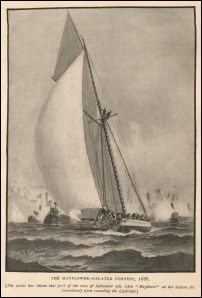 The yacht was just abreast two great excursion steamers that were black with thousands of excited spectators. Forgetting apparently in his enthusiasm the work he was to do, he took off his blue cap and waved it in the air, and in an instant, as though he had waved a magician’s wand, the black banks of spectators were silvered over with a sheen of fluttering white handkerchiefs, and 10,000 Yankees gave three cheers such as only Yankee can give, and which were scarce drowned by the pandemonium of whistles and screams that broke from the mob of 383 steamers. No such fleet of excursion boats so the oldest yachtsmen said, had ever gathered about the lightship and no yacht booming along to victory ever got such a salute. The yacht was just abreast two great excursion steamers that were black with thousands of excited spectators. Forgetting apparently in his enthusiasm the work he was to do, he took off his blue cap and waved it in the air, and in an instant, as though he had waved a magician’s wand, the black banks of spectators were silvered over with a sheen of fluttering white handkerchiefs, and 10,000 Yankees gave three cheers such as only Yankee can give, and which were scarce drowned by the pandemonium of whistles and screams that broke from the mob of 383 steamers. No such fleet of excursion boats so the oldest yachtsmen said, had ever gathered about the lightship and no yacht booming along to victory ever got such a salute.
The sailor put on his hat the long balloon jib crawled up the stay like a White Sea serpent from the Hudson to the topmast head. The yacht rose and fell broadside on in the trough of the sea, rose again, with the sea catching her under the port quarter, and then the magnificent great balloon split out from Its stop and fell fluttering aft to the shrouds. There may have been a time when the Mayflower’s crew could not do good work but the yachtsmen said it was a very long time ago, if ever.
BOSTON MAKES FOR HOME NINE MINUTES AHEAD.
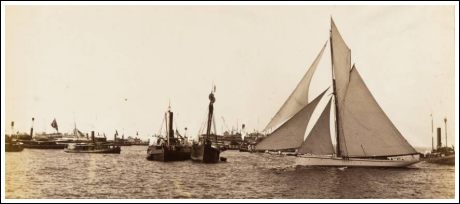
The Mayflower turned the lightship at 2h 35m 2s. Nine minutes and 11 seconds later the Galatea followed the Mayflower through the green lane around the big red lightship. She was greeted heartily. The excursionists felt that they could afford to be generous. She held on to her little jib topsail until she headed for home. Then it came down, not over fast, and her balloon started up. When two fathoms of it had crawled along the stay it had to come down and start over again. Something had been done wrong about it. The yachtsmen said her crew had been demoralized by unexpected defeat. After working with the sail for three minutes it was set. It did not appear to have over two-thirds as much cloth in it as the Mayflower’s. Both yachts then took in all smaller jibs and comfortably ploughed along at about eight knots an hour back to the black buoy off Sandy Hook.
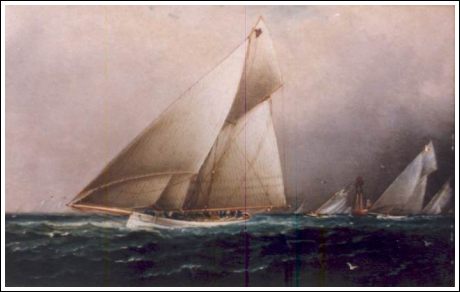
The excursion boats deserted the Galatea to overtake and escort the Mayflower, then half way to Scotland light. The big Columbia led the excursion fleet and Munro’s little red lightning launch Henrietta was her hated rival. The launch toyed with the monster like Jack with the Giant, and spurted away to make first one and then another of the captains of the trim steam yachts in the fleet feel that life was a burden.
THE GALATEA GETS SOME ELBOW ROOM AT LAST
Looking at the water off the Hook one almost wondered how the racers and their escort were going to get in. For more than a mile out the waiting fleet of yachts and oyster sloops lapped each other, sail on sail, and hull on hull. Never had such a fleet gathered there before, but before the yachts arrived in a majority of the little ones had blossomed spinnakers and other kites and were hurrying like a flock of snipe up the bay to the finish.
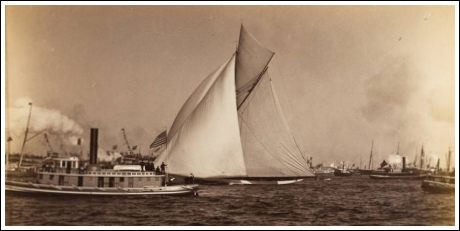
The Mayflower turned Buoy 8½ again at 3h 34m and shortly after she jibed around Buoy 10. Her spinnaker boom was lowered and her big sail sent out in stops but there it was allowed to hang. The balloon jib, a better sail, was pulling like a tug. Twelve minutes later, at 3h 46m, the Galatea, having lost nearly three minutes on the run in, jibed around the Spit and broke out her spinnaker. She had the best opportunity on the homestretch for the excursion fleet surrounded the leader, enthusiastically took her on their shoulders, so to speak, but instead of helping her becalmed her; still the Galatea did not gain much. A brisk flow of wind that swept over the bay just before the Mayflower leached the finish seemed to get to the Galatea first. The Mayflower kept away when it came for the home line, south of Fort Wadsworth, her sails balging under the force of the wind, her bow curling a feather of white on either side, and so with her crew waving their caps and even dancing with joy, she ploughed her way into the broad beIt of sunlight that stretched away as the home line from the committee’s boat to the green trees on Staten Island.
A WONDERFUL TIME AT THE FINISH.
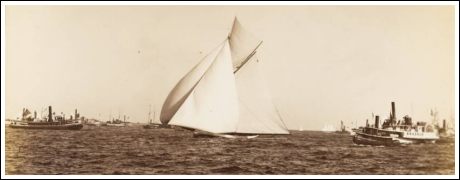
More than 400 boats awaited for coming. Again a path had been made for her. The happy throng would have built a triumphal arch above it had that been possible. The hearse welcome began when she was half a mile away, but words are inadequate to tell how the air became blue and sulfurous with smoke of gunpowder and then foggy with steam from heaven knows how many steamers, or how the tens of thousands on the boats cheered and were answered faintly, as it seem, by other cheers from the tens of thousands on the shores, or how women joined in the cheers with waving handkerchiefs, or stood silent with eyes wet with excitement. Never did the hills of Staten Island echo such a roar, and never had so great a throng gathered there to see a race finished.
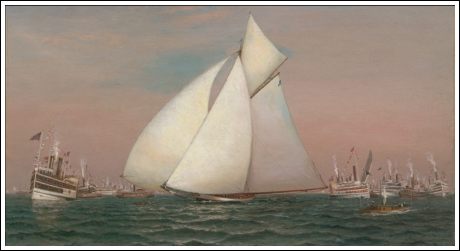
The Mayflower finished at 4h 22m m 53s. The Galatea came handsomely over the line 12m and 39s later, and was welcomed until the steamers ran their steam gauges down to hard pan.
The Mayflower had beaten her 12m 40s in actual sailing time and 12m 2s with time allowance.
When the Galatea came up past the judges' boat Lieutenant Henn, who seemed totake his defeat cheerfully, shouted:
“How much were we beaten?
- Twelve minutes” replied one of the regatta committee.
- I thought it was half an hour.” returned the lieutenant laughingly.
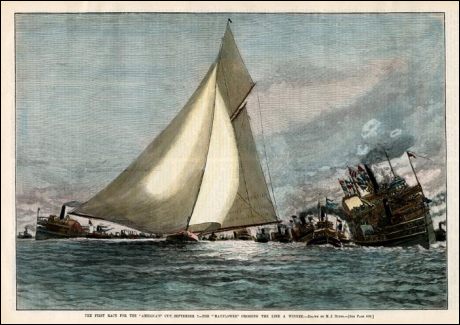
THE RACE IN FIGURES.
This is the official table showing the time of the start and finish of the yachts with the elapsed and corrected time:
| |
Start. |
Finish. |
Actual
Times. |
Corrected
Times. |
| |
H. |
M. |
S. |
H. |
M. |
S. |
H. |
M. |
S. |
H. |
M. |
S. |
| Mayflower |
10 |
56 |
12 |
4 |
22 |
53 |
5 |
26 |
41 |
5 |
26 |
41 |
| Galatea |
10 |
56 |
11 |
4 |
35 |
32 |
5 |
39 |
21 |
5 |
38 |
43 |
This table shows the time that elapsed in each of the four sections of the race and the Mayflower’s gain in each section:
| |
Start to
Buoy 8½. |
Buoy 8½
to Lightship. |
Lightship
to Buoy 8½. |
Buoy 8½
to Finish. |
| |
H. |
M. |
S. |
H. |
M. |
S. |
H. |
M. |
S. |
H. |
M. |
S. |
| Mayflower |
2 |
05 |
30 |
1 |
33 |
11 |
0 |
58 |
58 |
0 |
48 |
53 |
| Galatea |
2 |
10 |
56 |
1 |
37 |
06 |
1 |
01 |
47 |
0 |
49 |
32 |
| Mayflower's gain |
0 |
05 |
26 |
0 |
03 |
55 |
0 |
02 |
49 |
0 |
00 |
39 |
Thus while the Mayflower gained 5m 17s over the Galatea in beating against the wind from the start to Buoy 8½, she gained only 39s in running from Buoy 8½ back to the finish, nearly the same distance. The return trip was running before a light wind.
The times of the start, the finish, and every tack and turn were as follows:
| MAYFLOWER |
| |
|
H |
M |
S |
| |
Start |
10 |
56 |
12 |
| 1 |
Port |
11 |
00 |
30 |
| 2 |
Starboard |
11 |
12 |
30 |
| 3 |
Port |
11 |
21 |
00 |
| 4 |
Starboard |
11 |
27 |
00 |
| 5 |
Port |
11 |
34 |
00 |
| 6 |
Starboard |
11 |
41 |
00 |
| 7 |
Port |
11 |
49 |
00 |
| 8 |
Starboard |
12 |
03 |
30 |
| 9 |
Port |
12 |
09 |
00 |
| 10 |
Starboard |
12 |
19 |
30 |
| 11 |
Port |
12 |
24 |
30 |
| 12 |
Starboard |
12 |
38 |
30 |
| 13 |
Port |
12 |
42 |
10 |
| 14 |
Buoy 10 |
12 |
55 |
30 |
| 15 |
Buoy 8½ |
01 |
01 |
51 |
| 16 |
Port |
02 |
27 |
30 |
| 17 |
Lightship |
02 |
35 |
02 |
| 18 |
Buoy 8½ |
03 |
34 |
00 |
| 19 |
Buoy 10 |
03 |
37 |
55 |
| |
Finish |
04 |
22 |
53 |
|
 |
| GALATEA |
| |
|
H |
M |
S |
| |
Start |
10 |
56 |
11 |
| 1 |
Port |
11 |
00 |
30 |
| 2 |
Starboard |
11 |
13 |
30 |
| 3 |
Port |
11 |
27 |
30 |
| 4 |
Starboard |
11 |
34 |
45 |
| 5 |
Port |
11 |
47 |
00 |
| 6 |
Starboard |
11 |
55 |
00 |
| 7 |
Port |
11 |
59 |
00 |
| 8 |
Starboard |
12 |
12 |
30 |
| 9 |
Port |
12 |
20 |
00 |
| 10 |
Starboard |
12 |
35 |
00 |
| 11 |
Port |
12 |
40 |
00 |
| 12 |
Starboard |
12 |
53 |
30 |
| 13 |
Port |
12 |
54 |
00 |
| 14 |
Buoy 10 |
01 |
00 |
00 |
| 15 |
Buoy 8½ |
01 |
07 |
07 |
| 16 |
Port |
02 |
40 |
00 |
| 17 |
Lightship |
02 |
44 |
13 |
| 18 |
Buoy 8½ |
03 |
46 |
00 |
| 19 |
Buoy 10 |
03 |
50 |
00 |
| |
Finish |
04 |
35 |
32 |
|
|
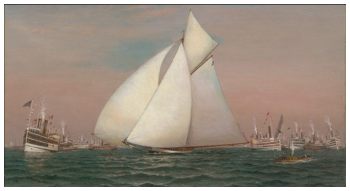 THE PEERLESS YANKEE WINS
THE PEERLESS YANKEE WINS